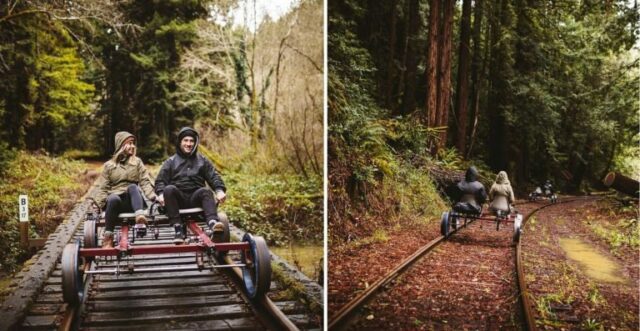
Sit back, breathe deep, and discover an entirely new way to explore California.
Pedaling along our historic tracks, bathed in dappled sunlight and a light breeze, you’ll experience a new freedom on the rails, unlike anything else. Without the need to steer, you’re unbound, able to look around at the wonder of this Continue reading “You Can Now Pedal Through The Redwood Forest On Rail Bikes” »

Nutella is one of the most popular spreads on the planet and many know how hard it is to resist those midnight Nutella-cravings. But do you know what goes into a jar of Nutella and what are its main components? Continue reading “This Image Reveals What Really Goes Into A Jar Of Nutella” »

Doomsday scenarios have come up a lot of times in these past months, as humankind is facing the first even pandemic of contemporary times.
It is only normal that many people have started planning in case there will be new threats facing our existence on Earth and some went as far as even building bunkers. Continue reading “Take a Look Inside a Massive Billionaires Bunker” »

There is a gardening hack that has been going viral online and it only requires one cheap item, a clear umbrella you could find at a local dollar store. A clear umbrella placed over your plants will act as a mini-greenhouse and trap humidity inside to keep the sprouts healthy and happy. Continue reading “Use Clear Umbrellas From The Dollar Store For A DIY Greenhouse Hack” »

Create a cheer and joy atmosphere with this tassel Christmas kitchen curtain tiers by Estmy. Charming button embellishments and pleating offer a unique and casual style that complements contemporary or vintage decor. Check out this in the link below… Continue reading “Christmas Tree Kitchen Curtain” »

This thing works. I had to handle some coop problems which meant moving two hens at once and this made the process way easier. They are also well made and easy to clean. If you have chickens, I highly recommend! These are available in the link below… Continue reading “Chicken Holder Bag” »

One of a kind Lord of The Rings themed Hobbit House. With hidden surprises around every turn. You won’t be able to stop uncovering the small details that will add to your enjoyment of your stay. Almost everything in the house was custom made by the builder to add to the unique charm of the house. From the medieval doors with operable speak easy look throughs and the whiskey barrel cabinets, you don’t want to miss putting this house on your travel bucket list. Continue reading “Ohiopyle Hobbit House” »

A recent study found that 1 of 4 people who use their Smartphone alarm oversleep!
This device ensures even the heaviest sleepers get up on time with it’s loud alarm and because he forces you out of bed.
Moreover, the procces of finding Clocky wakes you up and leaves you energized. Continue reading “This alarm clock will run away and hide of you if you don’t get out of bed” »

Richard Proenneke was an amateur naturalist who lived alone for nearly thirty years in the mountains of Alaska in a log cabin which he built with his own hands near the shore of Twin Lakes. Proenneke hunted, fished, raised and gathered his own food, and also had supplies flown in occasionally. He documented his activities in journals and on film, and also recorded valuable meteorological and natural data. Continue reading “This Man Lived Alone For Nearly 30 Years In The Mountains of Alaska In a Log Cabin Which He Built With His Own Hands” »























